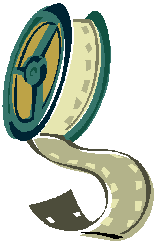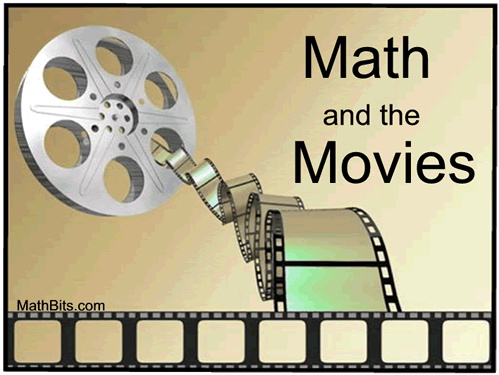|
 Movie Clips in the
Mathematics Classroom Movie Clips in the
Mathematics Classroom
Many of the students in today’s secondary (and college)
classrooms grew up watching attention-grabbing, action-packed
educational programs. These students now spend more hours in
front of a video screen than they do reading books. No wonder
students may find traditional mathematics education to be dull and boring.
So, what can mathematics
educators do to compete in this exciting and captivating world of
technology? The answer seems to be simple: embrace
technology in the classroom. Rather than lament the
disinterest of students, use any and all forms of technology to grab
and retain their attention. Consider presenting mathematical
content (not watered-down content) in a variety of educational
styles. Pedagogical variety will help to ensure students’
interest as well as maintain teacher enthusiasm and excitement for
mathematics.
 What is meant by movie
clips? What is meant by movie
clips?
The key word is “clips”. Clips are short excerpts
from movies, television, or educational videos that focus on a
particular issue or concept. Very few mathematics teachers can
afford the time to play a 30, 60 or 120 minute video during class.
(Also, playing entire movies in the classroom is often legally
questionable.) “Clips” of three minutes or less allow the
teacher to obtain the benefits of a longer video without the
intrusion upon class time.
| Clips fall into two main categories: |
|
 |
(1) Math in the Movies
– clips that demonstrate the actual mathematics at work, such as
seeing Abbott and Costello describe how 28 divided by 7 is 13.
(2) Math and
the Movies - clips that are used as a hook or humorous
introduction to a topic, such as watching Lucy and Ethel wrapping
chocolates on a conveyor belt prior to solving problems relating to
conveyor belts and sequences. |
 Using Clips
- things to remember: Using Clips
- things to remember:
(1) Purchase the movie/video that you will be
using rather than using a copy. Using a copy violates
international copyright laws. You may even wish to show the
VHS or DVD package to the students to impress upon them that a purchased original is being used. Using clips that are viewable
from a web site, assumes that the web site owner has obtained legal
permission to post such clips. (This may or may not be true.)
(2) Always preview a clip before showing it to your
class. While a colleague may find the clip useful, you are the
best judge of what will be appropriate and useful for your students.
(3) As with all educational materials, choose clips
that are tastefully done and are age appropriate. Avoid any
clips that contain profanity, nudity (regardless of the degree or
length), or are insensitive to the diversity in your classroom. Such
characteristics will distract from the objective of using the clip
and may spur unwanted discussions.
(4) Limit the clip to showing only the
information that is relevant to the mathematical concept you are
trying to develop. Do not give in to students’ begging to see
more of the video. Showing more of the video than is needed to
make your point will cause students to lose their concentration on
the task at hand.
(5) Before class begins,
be
sure that your equipment is working properly and you know how to
adjust the settings. Do not assume that equipment will always
operate properly. Equipment left in classrooms often falls
prey to re-adjustments by idol fingers.
(6) Before class begins,
fast forward the DVD/tape to the location of the clip. Prior
planning will save class time and avoid students’ attention from
wandering while you fiddle with the equipment.
(7) Set the stage for the
clip. A brief description of the story plot may be needed
prior to the clip to give meaning to the clip. The students
may need to be directed as to what specifically to watch for in the
clip. A question sheet may be handed out prior to the clip to
direct student viewing. Certain clips may be shown without an
introduction, for their affect, and then re-shown for focus.
(8) As with all educational
tools, do not overuse clips. Intermingle clips with your other
teaching strategies in a manner that will remain stimulating to your
students.

MathBits Main Page | Math Movies PART 1 | MathMovies PART 2 | Terms of Use
|

